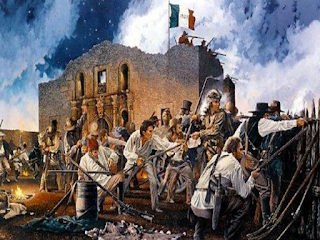The Alamo was built as a mission, not a fort. So, the Texans had to work hard to build higher and thicker walls, add cannons, and add high fences made of stakes.
The belligerents were the Mexican Republic—under command of Antonio López de Santa Anna—versus the newly declared Republic of Texas—under command of William Barret Travis.
In December 1835 after the Battle of San Antonio, many Texans thought that the centralist threat to Texas had ended.
On Tuesday, February 23, 1836, General Antonio López de Santa Anna arrived in San Antonio that afternoon with the vanguard of his army. Mexican forces quietly occupy San Antonio and begin surrounding the Alamo.
A bloodred banner was raised atop the bell tower of San Fernando Church, signifying that no prisoners would be taken. Colonel William B. Travis ordered a cannon fired in response. Santa Anna was outraged. The Mexican soldiers fired back.
The Texans were unaware that Santa Anna had decided to lead his army into Texas. They believed that he would wait until spring to launch an attack. As a result, the Texas forces remained unorganized and scattered. Their lack of preparation would ultimately cost them at their next encounter with Mexican troops, the Battle of the Alamo.
The siege of the Alamo had begun. Mexican artillery began to bombard the fort. Santa Anna wanted to smash down the walls. It was to last 13 days. All but a few of the 200 defenders of the Alamo are killed in battle. The prisoners are executed. Santa Anna reports 70 of his men killed, while reports claim as many as 400 men killed.
Battle of the Alamo 1836 CE (February 23 – March 6, 1836)
The belligerents were the Mexican Republic—under command of Antonio López de Santa Anna—versus the newly declared Republic of Texas—under command of William Barret Travis.
In December 1835 after the Battle of San Antonio, many Texans thought that the centralist threat to Texas had ended.
On Tuesday, February 23, 1836, General Antonio López de Santa Anna arrived in San Antonio that afternoon with the vanguard of his army. Mexican forces quietly occupy San Antonio and begin surrounding the Alamo.
A bloodred banner was raised atop the bell tower of San Fernando Church, signifying that no prisoners would be taken. Colonel William B. Travis ordered a cannon fired in response. Santa Anna was outraged. The Mexican soldiers fired back.
The Texans were unaware that Santa Anna had decided to lead his army into Texas. They believed that he would wait until spring to launch an attack. As a result, the Texas forces remained unorganized and scattered. Their lack of preparation would ultimately cost them at their next encounter with Mexican troops, the Battle of the Alamo.
The siege of the Alamo had begun. Mexican artillery began to bombard the fort. Santa Anna wanted to smash down the walls. It was to last 13 days. All but a few of the 200 defenders of the Alamo are killed in battle. The prisoners are executed. Santa Anna reports 70 of his men killed, while reports claim as many as 400 men killed.
Battle of the Alamo 1836 CE (February 23 – March 6, 1836)

















